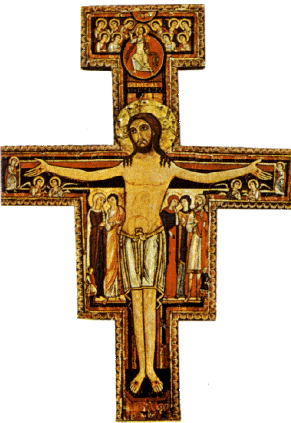|
Francis of Assisi (1182-1226) Founder of the Franciscan Order in the Catholic Church. A brief summary of his life (below) To
the right is depicted what is now called the San Damiano
Crucifix, long associated with St. Francis. It is painted by
an unknown Umbrian artist in the 12th century with strong Syrian
stylistic influence. |
 |
Francis of Assisi, Saint (1182-1226), Italian
mystic and preacher, who founded the Franciscans. Born in Assisi, Italy and
originally named Giovanni Francesco Bernardone, he appears to have received
little formal education, even though his father was a wealthy merchant. As a
young man, Francis led a worldly, carefree life. Following a battle between
Assisi and Perugia, he was held captive in Perugia for over a year. While
imprisoned, he suffered a severe illness during which he resolved to alter
his way of life. Back in Assisi in 1205, he performed charities among the
lepers and began working on the restoration of dilapidated churches.
Francis's change of character and his expenditures for charity angered his
father, who legally disinherited him. Francis then discarded his rich
garments for a bishop's cloak and devoted the next three years to the care
of outcasts and lepers in the woods of Mount Subasio.
For his devotions on Mount Subasio, Francis restored the ruined chapel of
Santa Maria degli Angeli. In 1208, one day during Mass, he heard a call
telling him to go out into the world and, according to the text of Matthew
10:5-14, to possess nothing, but to do good everywhere.
Upon returning to Assisi that same year, Francis began preaching. He
gathered round him the 12 disciples who became the original brothers of his
order, later called the First Order; they elected Francis superior. In 1212
he received a young, well-born nun of Assisi, Clare, into Franciscan
fellowship; through her was established the Order of the Poor Ladies (the
Poor Clares), later the Second Order of Franciscans. It was probably later
in 1212 that Francis set out for the Holy Land, but a shipwreck forced him
to return. Other difficulties prevented him from accomplishing much
missionary work when he went to Spain to preach to the Moors. In 1219 he was
in Egypt, where he succeeded in preaching to, but not in converting, the
sultan. Francis then went on to the Holy Land, staying there until 1220. He
wished to be martyred and rejoiced upon hearing that five Franciscan friars
had been killed in Morocco while carrying out their duties. On his return
home he found dissension in the ranks of the friars and resigned as
superior, spending the next few years in planning what became the Third
Order of Franciscans, the tertiaries.
In September 1224, after 40 days of fasting, Francis was praying upon Monte
Alverno when he felt pain mingled with joy, and the marks of the crucifixion
of Christ, the stigmata, appeared on his body. Accounts of the appearance of
these marks differ, but it seems probable that they were knobby
protuberances of the flesh, resembling the heads of nails. Francis was
carried back to Assisi, where his remaining years were marked by physical
pain and almost total blindness. He was canonized in 1228. In 1980, Pope
John Paul II proclaimed him the patron saint of ecologists. In art, the
emblems of St. Francis are the wolf, the lamb, the fish, birds, and the
stigmata. His feast day is October 4.
Rev.Theodore M. Hesburgh
